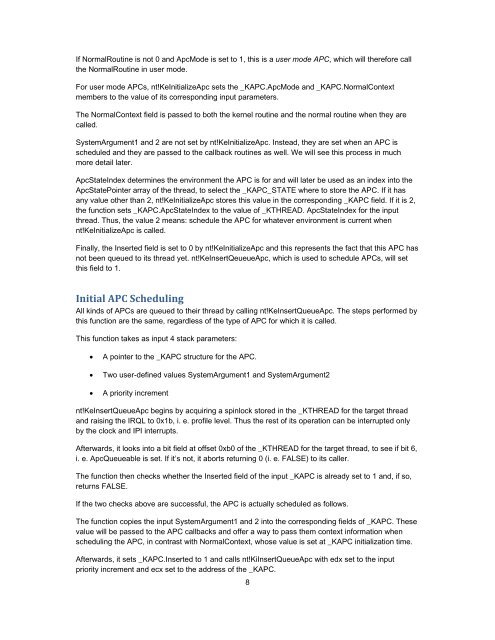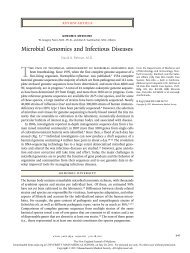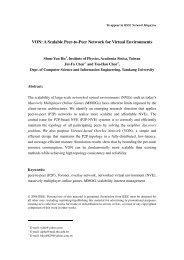366.7 KB - Evernote
366.7 KB - Evernote
366.7 KB - Evernote
Create successful ePaper yourself
Turn your PDF publications into a flip-book with our unique Google optimized e-Paper software.
If NormalRoutine is not 0 and ApcMode is set to 1, this is a user mode APC, which will therefore call<br />
the NormalRoutine in user mode.<br />
For user mode APCs, nt!KeInitializeApc sets the _KAPC.ApcMode and _KAPC.NormalContext<br />
members to the value of its corresponding input parameters.<br />
The NormalContext field is passed to both the kernel routine and the normal routine when they are<br />
called.<br />
SystemArgument1 and 2 are not set by nt!KeInitializeApc. Instead, they are set when an APC is<br />
scheduled and they are passed to the callback routines as well. We will see this process in much<br />
more detail later.<br />
ApcStateIndex determines the environment the APC is for and will later be used as an index into the<br />
ApcStatePointer array of the thread, to select the _KAPC_STATE where to store the APC. If it has<br />
any value other than 2, nt!KeInitializeApc stores this value in the corresponding _KAPC field. If it is 2,<br />
the function sets _KAPC.ApcStateIndex to the value of _KTHREAD. ApcStateIndex for the input<br />
thread. Thus, the value 2 means: schedule the APC for whatever environment is current when<br />
nt!KeInitializeApc is called.<br />
Finally, the Inserted field is set to 0 by nt!KeInitializeApc and this represents the fact that this APC has<br />
not been queued to its thread yet. nt!KeInsertQeueueApc, which is used to schedule APCs, will set<br />
this field to 1.<br />
Initial APC Scheduling<br />
All kinds of APCs are queued to their thread by calling nt!KeInsertQueueApc. The steps performed by<br />
this function are the same, regardless of the type of APC for which it is called.<br />
This function takes as input 4 stack parameters:<br />
• A pointer to the _KAPC structure for the APC.<br />
• Two user-defined values SystemArgument1 and SystemArgument2<br />
• A priority increment<br />
nt!KeInsertQueueApc begins by acquiring a spinlock stored in the _KTHREAD for the target thread<br />
and raising the IRQL to 0x1b, i. e. profile level. Thus the rest of its operation can be interrupted only<br />
by the clock and IPI interrupts.<br />
Afterwards, it looks into a bit field at offset 0xb0 of the _KTHREAD for the target thread, to see if bit 6,<br />
i. e. ApcQueueable is set. If it’s not, it aborts returning 0 (i. e. FALSE) to its caller.<br />
The function then checks whether the Inserted field of the input _KAPC is already set to 1 and, if so,<br />
returns FALSE.<br />
If the two checks above are successful, the APC is actually scheduled as follows.<br />
The function copies the input SystemArgument1 and 2 into the corresponding fields of _KAPC. These<br />
value will be passed to the APC callbacks and offer a way to pass them context information when<br />
scheduling the APC, in contrast with NormalContext, whose value is set at _KAPC initialization time.<br />
Afterwards, it sets _KAPC.Inserted to 1 and calls nt!KiInsertQueueApc with edx set to the input<br />
priority increment and ecx set to the address of the _KAPC.<br />
8
















